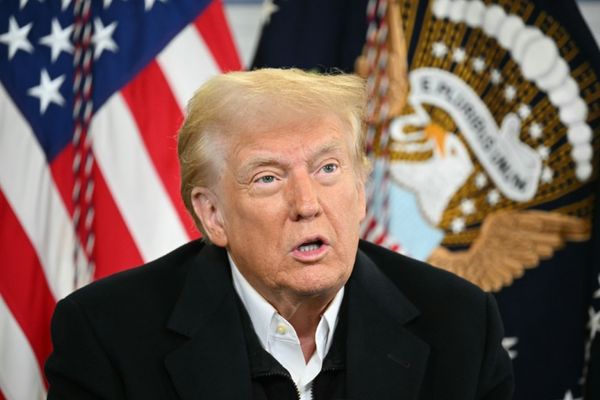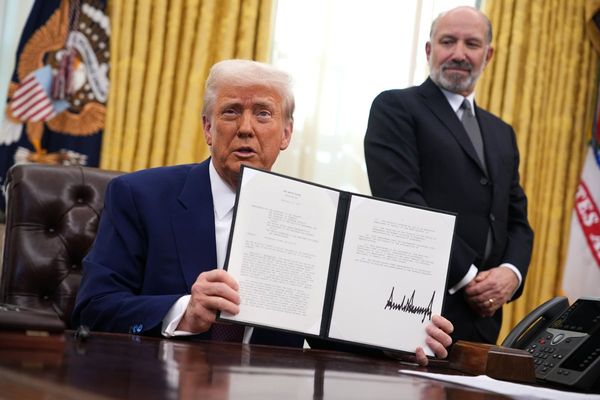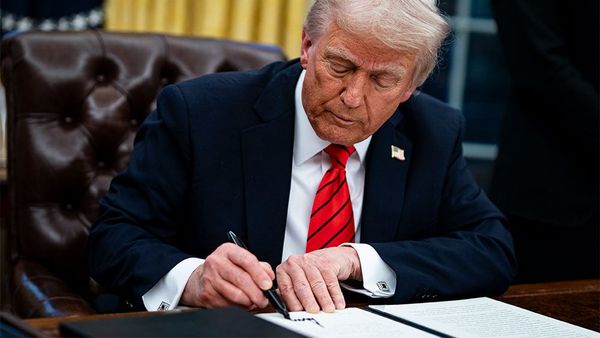
- President Donald Trump’s reciprocal tariff program is being viewed with mounting skepticism over whether it will ultimately go into effect or be used as a bargaining chip in international trade negotiations.
Investors had waited with bated breath for news of the reciprocal tariffs President Donald Trump warned he would implement this week, but instead he announced they would be delayed to a future date. Rather than imposing tariffs right away, the president directed federal agencies to study them over the next several months.
Stocks jumped Thursday as investors breathed a sigh of relief that American trade policy would not upend global commerce—for now. Tariffs could result in higher prices for U.S. consumers and businesses as well as retaliatory tariffs from other countries.
“Yesterday was U.S. President Trump’s very big announcement on reciprocal tariffs, which turned out to be a plan to investigate taxing U.S. consumers at a future date,” UBS Global Wealth Management chief economist Paul Donovan wrote in a note to investors.
Many investors believe that the threats of blanket tariffs, which were a core campaign message in 2024, are more of a negotiation tactic meant to try to recalibrate trade relationships in the U.S.’s favor.
But whether or not Trump and his new administration intend to truly take the plunge on the blanket tariffs he advocated for remains to be seen.
So far, the message on tariffs has been mixed. The talk has been unequivocal: Tariffs are coming for adversaries and allies alike, and they will be severe. However, in practice their implementation, when it has happened, has been more measured, reflecting the delicate nature of global trade negotiations.
Earlier this month, Trump announced tariffs on Canada and Mexico, but backed off two days later when the two countries made other concessions. His tariffs on China went into effect, but he then pulled back ones on low-cost goods. He also unveiled tariffs on steel and aluminum that will go into effect next month.
“Markets had to decide whether the president was being a protectionist or a pushover, and for now are erring toward pushover,” wrote Donovan. “The delay is seen as an opportunity to do ‘deals.’ So far, such deals have been more spin than substance.”
The White House did not immediately respond to a request for comment.
Others on Wall Street are also wondering if Trump’s tariff talk is more bark than bite.
The delaying of the tariffs was one of the major themes of the week, Macquarie global foreign exchange and rates strategist Thierry Wizman told investors.
“There has been a clear deceleration of the ‘tariff train,’ even as the headlines about U.S. import tariffs remain frequent,” Wizman wrote. “There’s a sense that the administration’s approach to economic and national security issues is more ‘transactional,’ and less ‘punitive.’”
Since Trump took office last month, the U.S. government has begun renegotiating its trade relationships with various countries. On Thursday, Indian Prime Minister Narendra Modi pledged to reduce tariffs on some U.S. goods, after India already said it would lower tariffs on bourbon whiskey from 150% to 100%.
To stave off any potential reciprocal tariffs, India—whose largest trading partner is the U.S.—also agreed to buy more oil and gas and increase its purchases of defense equipment from American firms.
However, not all of the trade discussions between the U.S. and its allies have gone as smoothly. And perhaps more notably, on more than one occasion the tariffs that Trump threatened didn’t go into effect.
A war of words erupted after Trump announced he intended to levy 25% tariffs on Mexico and Canada. Eventually the two reached separate deals with the U.S. to delay the tariffs by a month.
Trump also already offered some early glimpses into his preference to use tariffs as a means to exact other foreign policy concessions, such as when he threatened Colombia with a raft of tariffs if it didn’t accept a military aircraft repatriating undocumented Colombians slated for deportation.
Trump’s reciprocal tariff plans this week came on the back of the release of the latest inflation data. The consumer price index ticked up to 3% in January from 2.9%. While the slightly higher rate of inflation was not ideal news for the economy, it could serve as a further deterrent to the sort of gung ho tariff policy Trump has advocated for, according to Wizman.
“The ‘silver lining’ with the high U.S. CPI inflation print yesterday is that it ‘boxes in’ U.S. President Donald Trump,” he wrote to investors. “Inflation would make Trump less likely to tariff, insofar as tariffs, on top of already-high inflation, could take inflation to politically unpalatable levels.”










